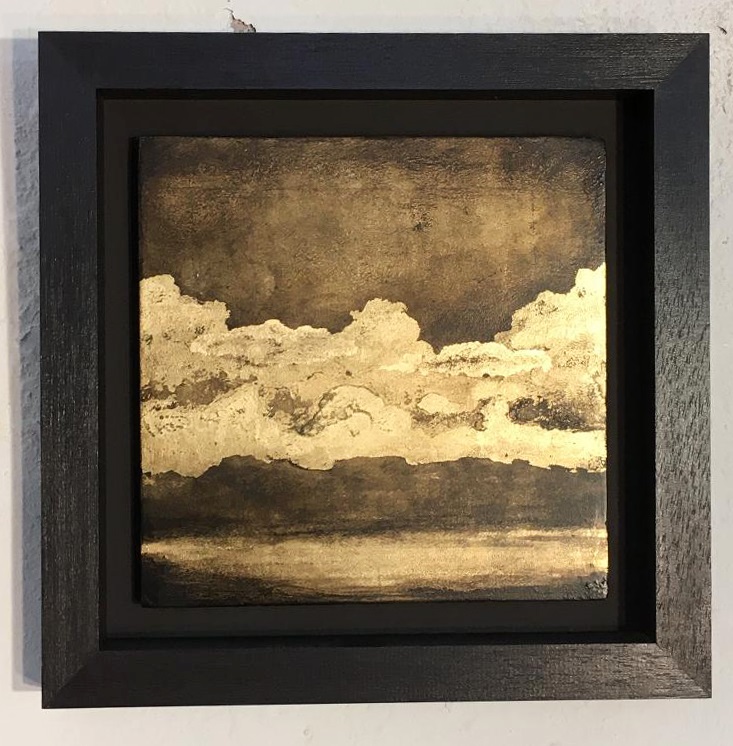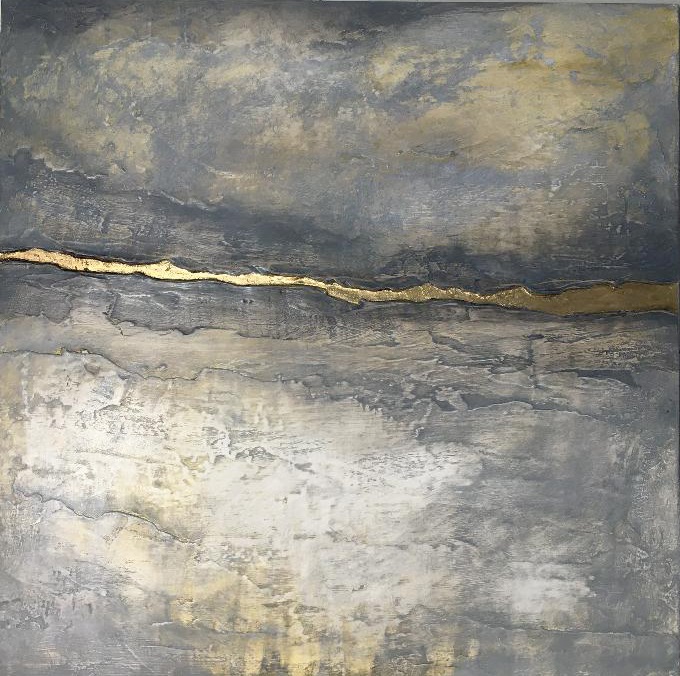
AFTER 26 years under Terry Brett’s stewardship, Pyramid Gallery is showing signs of Rust…but in a good way.
On the first floor of the Stonegate premises in York, he is exhibiting rust prints and paintings by Rogues Atelier artist, upholsterer and interior designer Jo Walton until the end of September.
In these Covid-compromised times, the works can be viewed Monday to Saturday, from 10am to 5pm, with access restricted to a maximum single group up to six people or two separate groups of one or two at any one time. Alternatively, take a look online at pyramidgallery.com.
Jo’s works are abstract, inspired by horizons, whether rust prints on paper and plaster, combining rusted metal with painting, or seascapes on gold-metal leaf.
“Jo uses rust and rusted metal sheets in innovative ways to create art works,” says Terry. “Iron filings are used as ‘paint’ and as they rust, reactions occur, every painting being unique and unrepeatable.
“Jo also uses oils to paint sea and landscapes onto gold and silver lead, resulting in deep, rich and unique paintings.”
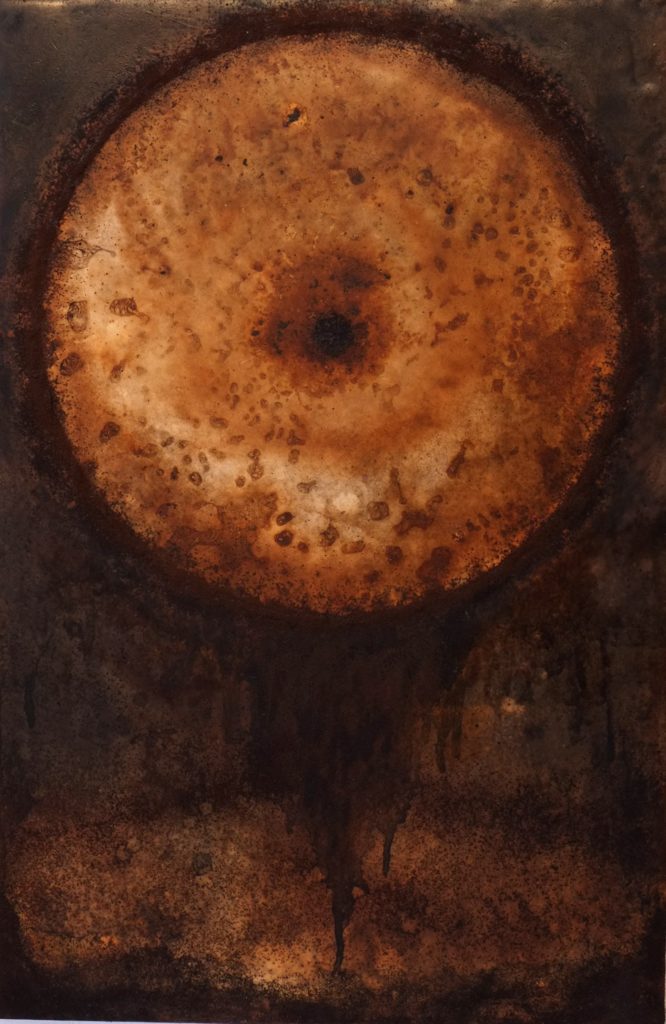
Her artwork reflects both her childhood in Australia and her days, as a young woman, spent sailing oceans, from the Mediterranean to the Caribbean.
After many years of travelling, Jo returned to England, studying fine art at Bradford University and now exhibiting all year round – until the Covid lockdown – from her York studios, Rogues Atelier, an old tannery in Franklins Yard, Fossgate, that she shares with jeweller and fellow York Open Studios exhibitor Emma Welsh and international textile artist Robert Burton.
In her “other life”, Jo is an upholsterer, initially learning her skills from making cushions and sail covers for yachts when living in Greece. She gained her City and Guilds qualification in modern and traditional upholstery and has taught the subject for many years for City of York Council.
“Occasionally, my skills have the opportunity to blend into a ‘huge blank canvas’: interior design,” says Jo, who founded and designed the Space 109 community arts centre in Walmgate, York, in 2006, along with creating and teaching many of the art and community projects there.
She later converted three empty shops on Bishopthorpe Road into Angel on The Green, a bar and café and home to comedy nights and exhibitions that had to “flow with a solid theme throughout”. “It was quite a step to move on to a bar from a community project,” she says.
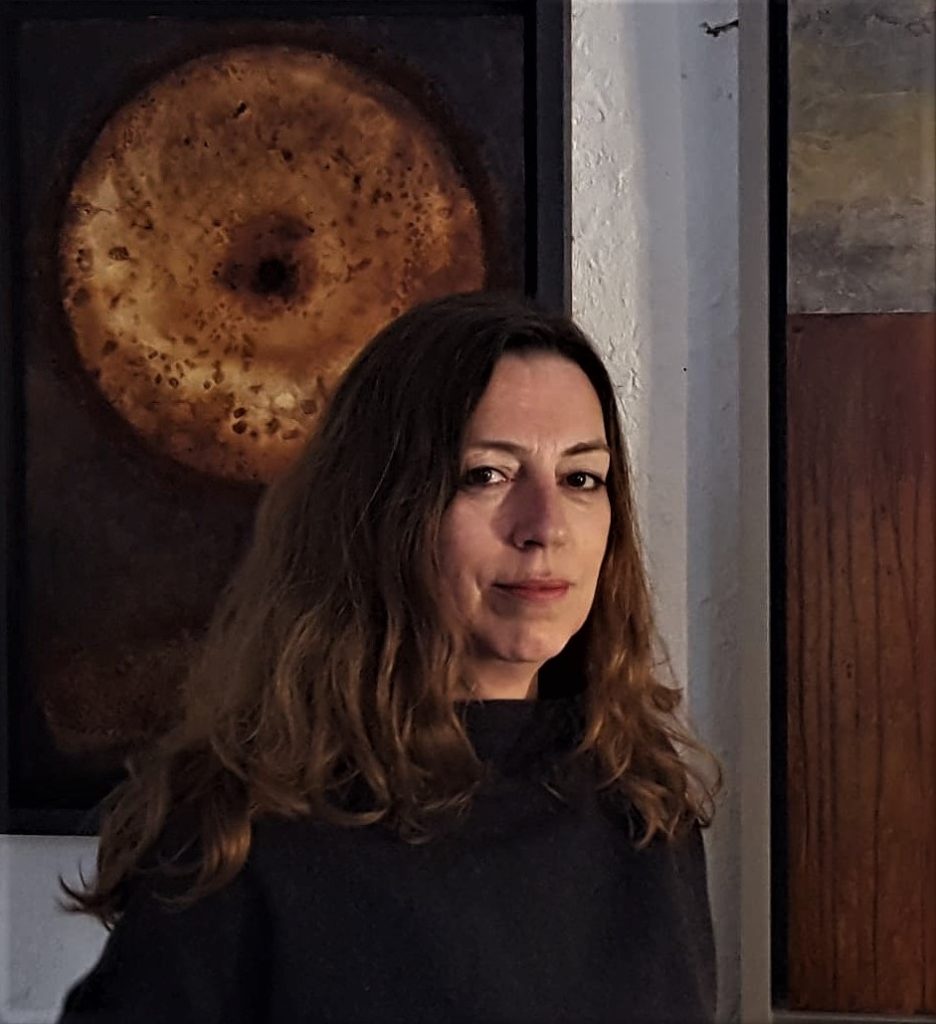
In between, Jo created the Rogues Atelier studios, where she takes on upholstery commissions and runs upholstery and cushion-making workshops. In Leeds, she has designed the interior of Rafi’s Spice and the Bluebird Bakery, both in Kirkgate Market.
Defining her artwork, Jo says: “My paintings are an attempt to capture memories, an intrinsic feeling, a distant dream. As a child I travelled to and from Australia by sea. Since then, in my adult years, I’ve spent many days, nights, years, sailing around the Mediterranean, across the Atlantic, in the Gulf of Aqaba, the Red Sea, the Irish Channel and Bay of Biscay. Each day and night providing a wonderful visual feast of clouds, sea, sun-setting and moon-rising.
“I used to deliver yachts worldwide with a minimal crew. Then, the birth of my daughter Blythe served as a beautiful anchor, which landed me in England.
“These images are ingrained in my mind and surface through my art, always seeking the horizon and the contrast from the sun or moon. I work on gold or silver metal leaf to illustrate the ever-present light when on the sea.”
Jo has always been fascinated by rust, the colours from burnt orange to umber, its weathered, changing surface and slow development. “The colours resonate with my childhood; memories of Australia with its red earth, running around farms with metal shacks, rusted corrugated roofs, broken machinery,” she says.
“I’ve collected pieces over the years – not knowing what to do with them but unwilling to let these beautiful ‘lumps of junk’ go.”

Eventually, Jo discovered the method of persuading the surface rust to leave its metal and imprint onto paper and fabric. “This has now rendered my objects useful, as well as beautiful. The process is slow and always experimental with only a relatively small amount of control over the end result, which can never be repeated exactly.
“The rust is forever changing, as are the solutions of chemicals on its surface. No two prints are ever the same,” she says. “It feels like alchemy.”
Jo finally found the confidence to produce work by carefully rusting the metal and presenting it as the art in its own right. “It was the initial impact of the rusted object that always mesmerised me,” she says.
“The method to preserve and prevent further rusting of the metal plate has been researched, tried and tested by myself over the past five years to the point where I’m in no doubt of its durability.”
Here Charles Hutchinson puts a series of questions to Jo Walton on the subjects of alchemy, rust, painting, sailing, horizons, studios and teaching.
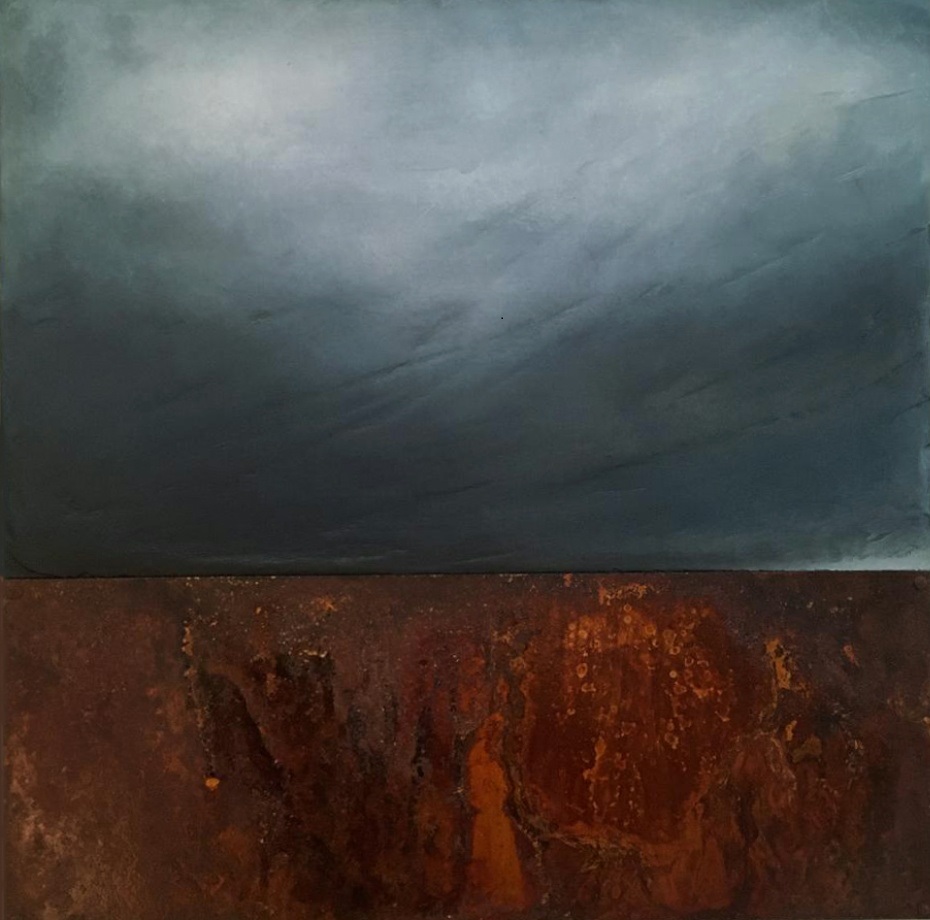
Is your work a meeting of science (chemistry) and art: the very essence of alchemy?
“It does feel like alchemy to me but I can’t say I’ve studied the science, apart from how to preserve the results.”
It is always said an artist never knows when a work is finished, but eventually has to let go? How do you reach that moment and is it more difficult because of the unpredictable behaviour of the materials you use?
“With the rust pieces, it’s always small adjustments and then waiting to see the results the rusted metal will give. It’s done when it resonates a certain chord for me – same with the paintings. It can be a long process.”
How did you discover your rust-removing technique: was it serendipitous – like the invention of glass – or was it experimental, with a method being applied?
“I got a rust stain on my jeans and it wouldn’t wash out. As a trained printmaker, I thought I can do something with that! So, I started playing with my rust collection…there was a lot of trial and error before I got some really satisfying results.”
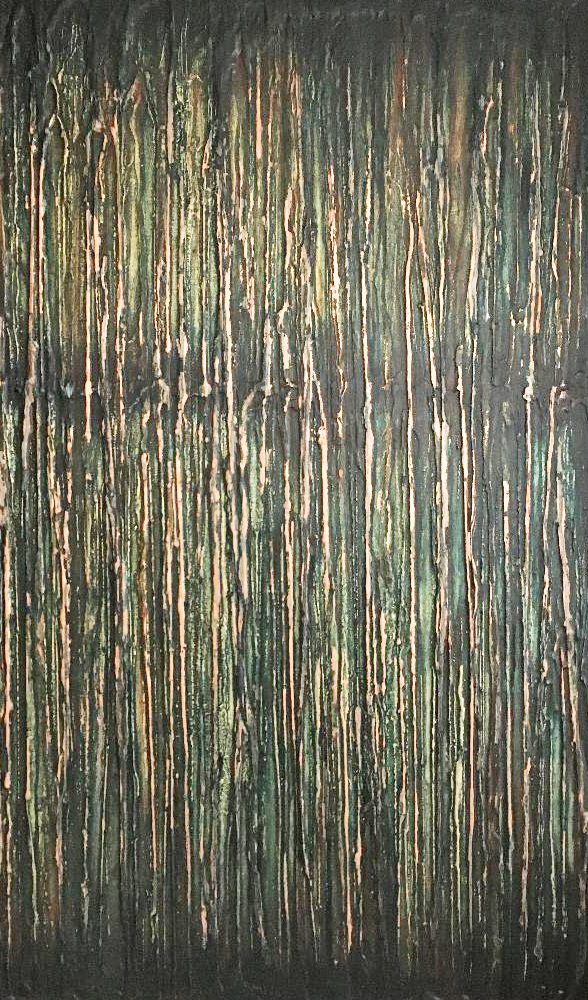
At sea, when sailing, you have the horizon in perma-view, but you are always in motion with the movement of the sea below. In your artwork, do you seek to freeze a moment and then for the viewer to release it again?
“I guess so, although you can be in the middle of the Atlantic and sometimes it’s as flat as a pond! It’s like sailing on a mirror.
“I seek to preserve a notion, a dream-like memory of those experiences. I love watching people view my art: some glance and walk straight past and others stare for a long time. Some of those people have sailed oceans too and bought my work. That means so much to me.”
Why is light so important to you in your work?
“I use gold metal leaf to catch and reflect the light in the way that water does. It’s symbolic of the light on the sea.”
How do you achieve that burnished quality in your works?
“Paint and remove, paint again… many thin layers.”

Is it more challenging to work to a limited range of colours or do the works gain more from bringing out everything from that palette?
“My paintings have been compared to etchings, which are fairly limited in colour, but I guess it’s just what I do with that subject matter. With portraits or other subjects, the palette will be totally different.”
You had to forego your sixth successive York Open Studios in April, amid the lockdown. What’s next for you? More exhibitions? Any commissions?
“Covid has wiped out any plans that were in place for most artists and makers. Hopefully next year will be better. I’m very fortunate to be exhibiting with Terry at Pyramid. As far as commissions go – they are carefully considered!”
How does your interior design work, such as for the Angel on The Green on Bishopthorpe Road, differ as an artistic challenge from your artworks?
“Strangely, not much different artistically. I was still seeking to balance the overall image but on a huge canvas, with more ingredients, a lot more planning and paperwork. The big difference was working with a team of great people, which was a lot of fun.”
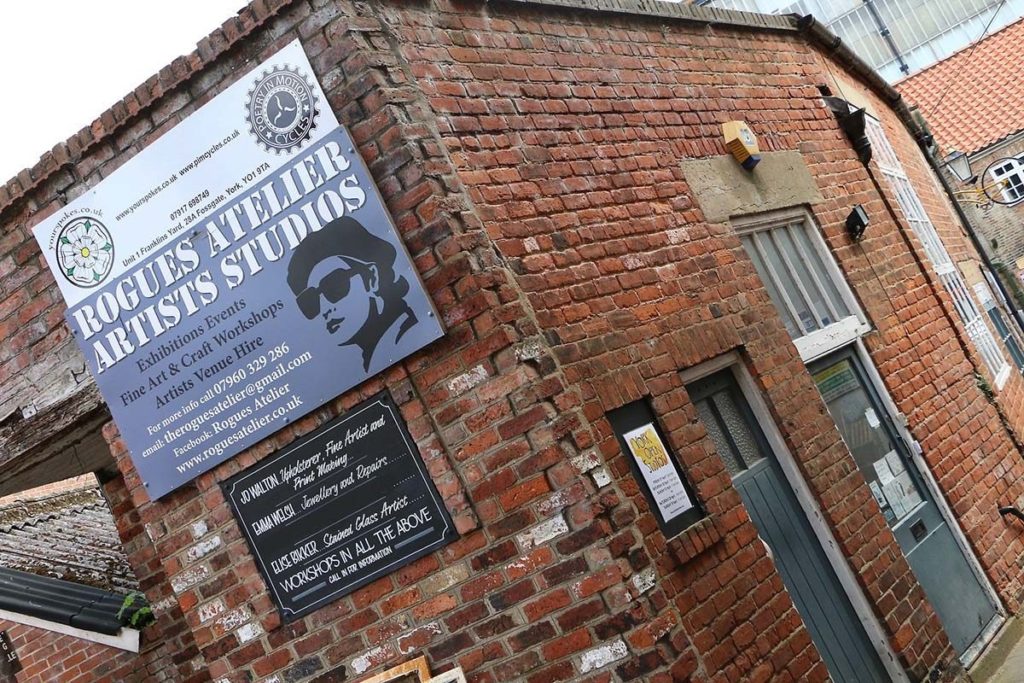
What has the Rogues Atelier studio brought to your artistic life?
“The possibility to work big, make a huge mess and to participate in events like York Open Studios and the other fairs we do as a group of artists. Rogues Atelier is so central in York that we have a lot of visitors and interest in what we do.”
Do you still sail? If not, do you miss it?
“I stopped sailing when I ended up back in England. I do miss it and often wonder how I’ve ended up so far away from the sea.”
How is the teaching going?
“I don’t teach art anymore as I found that the energy I give to it takes away from the energy I need for my own ideas. I do still love teaching though and hold regular courses in upholstery.”
What is the first piece of advice you give in your upholstery classes?
“Good question. First piece is how to avoid injuring yourself! Second is to not to attempt a winged-back armchair as your first piece…”
Jo Walton is exhibiting Paintings and Rust Prints at Pyramid Gallery, Stonegate, York, until September 30.
